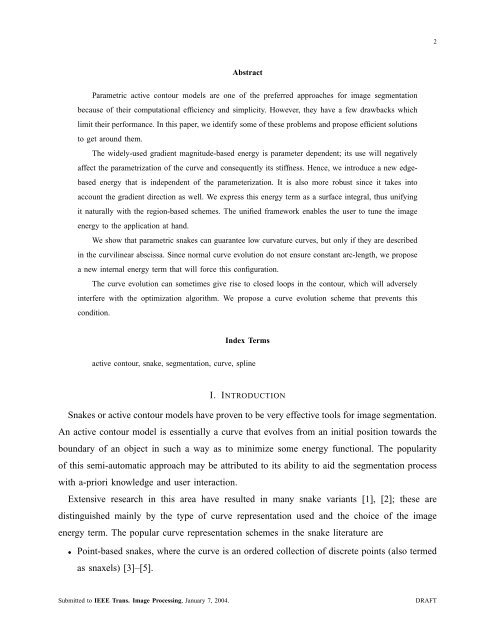Efficient energies and algorithms for parametric snakes - EPFL
Efficient energies and algorithms for parametric snakes - EPFL
Efficient energies and algorithms for parametric snakes - EPFL
Create successful ePaper yourself
Turn your PDF publications into a flip-book with our unique Google optimized e-Paper software.
2AbstractParametric active contour models are one of the preferred approaches <strong>for</strong> image segmentationbecause of their computational efficiency <strong>and</strong> simplicity. However, they have a few drawbacks whichlimit their per<strong>for</strong>mance. In this paper, we identify some of these problems <strong>and</strong> propose efficient solutionsto get around them.The widely-used gradient magnitude-based energy is parameter dependent; its use will negativelyaffect the parametrization of the curve <strong>and</strong> consequently its stiffness. Hence, we introduce a new edgebasedenergy that is independent of the parameterization. It is also more robust since it takes intoaccount the gradient direction as well. We express this energy term as a surface integral, thus unifyingit naturally with the region-based schemes. The unified framework enables the user to tune the imageenergy to the application at h<strong>and</strong>.We show that <strong>parametric</strong> <strong>snakes</strong> can guarantee low curvature curves, but only if they are describedin the curvilinear abscissa. Since normal curve evolution do not ensure constant arc-length, we proposea new internal energy term that will <strong>for</strong>ce this configuration.The curve evolution can sometimes give rise to closed loops in the contour, which will adverselyinterfere with the optimization algorithm. We propose a curve evolution scheme that prevents thiscondition.Index Termsactive contour, snake, segmentation, curve, splineI. INTRODUCTIONSnakes or active contour models have proven to be very effective tools <strong>for</strong> image segmentation.An active contour model is essentially a curve that evolves from an initial position towards theboundary of an object in such a way as to minimize some energy functional. The popularityof this semi-automatic approach may be attributed to its ability to aid the segmentation processwith a-priori knowledge <strong>and</strong> user interaction.Extensive research in this area have resulted in many snake variants [1], [2]; these aredistinguished mainly by the type of curve representation used <strong>and</strong> the choice of the imageenergy term. The popular curve representation schemes in the snake literature are• Point-based <strong>snakes</strong>, where the curve is an ordered collection of discrete points (also termedas snaxels) [3]–[5].Submitted to IEEE Trans. Image Processing, January 7, 2004.DRAFT
















